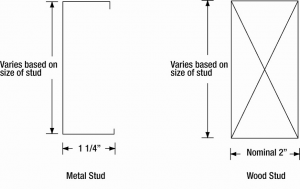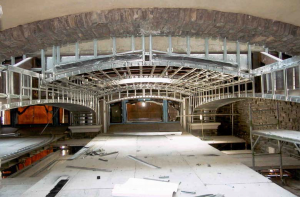General Application Provisions (Preview)
Framing members to which gypsum panel products are to be attached should be installed so that they are straight and true. Bent, twisted, cut, split, or otherwise damaged framing members should be not be used. Unless part of a specific design, all framing members should be in plane and should not vary by more than 1/8 inch (3 mm) from the faces of adjacent framing members.
The attachment surface for a panel should not be less than 1 ½ inches (38 mm) wide for wood and 1 ¼ inches (32 mm) wide for steel framing members. At internal corners, bearing surfaces should not be less than ¾ inch (19 mm) wide.
Nonstructural cold-formed steel framing members, including furring channels, shall be not less than 0.0179 in. (0.455 mm) and manufactured in compliance with AISI S220 or ASTM C645. Where such studs are to receive abuse-resistant or impact resistant panels, steel framing members shall be not less than .0296 in. (0.752 mm) base metal thickness.
Thicker, load-bearing steel studs should have a base metal thickness from 0.0329 in. (0.836 mm) to 0.118 in (2.82 mm) and comply with AISI S240 or ASTM C955. Steel framing members should be straight, free of rust or other visible damage and should be installed based on the criteria of ASTM C754 for non-load bearing studs or ASTM C1007 for load-bearing studs.
Many installations incorporate the use of rigid furring channels or resilient furring channels. GA-216 should be consulted for specific criteria regarding the installation of rigid furring channels and resilient furring channels.
Wood framing members should be of the proper grade for the intended use and should comply with the Department of Commerce Voluntary Product Standard PS 20 American Softwood Lumber Standard or CAN/CSA-0141. Wood framing members should be closely monitored to verify that materials do not have a moisture content in excess of that prescribed by the pertinent standard. In addition, compliance should be maintained with any model code requirements that define wood framing member moisture content.
Panels should be applied first to ceilings and then to walls. This ensures that panel ends on ceilings will be properly supported by panels applied to walls.
When installed to steel framing members, gypsum panels should be applied so the leading edge of each panel product is attached to the open or unsupported edge of the steel stud flange.
Holes, such as those for pipes, fixtures, or other penetrations, should be scored on both the face and back of the panel before removal of the cut-out with a saw. Holes may also be cut out with a router or other special tool designed for the purpose.
Holes should be neatly cut to the approximate size of the penetrating item. The annular space surrounding the penetrating item should be sealed as mandated by model code requirements.
Panels should be installed so that joints on the opposite sides of a partition do not occur on the same stud. Diagram A, below, illustrates the concept.

In addition, in single layer panel application, end joints parallel to and on the same side of framing members should be staggered between alternate courses of panel products and from joints on the opposite side of the framing member. The elevation sketch in Diagram B, above, illustrates the concept.
In multi-layer panel systems, end joints parallel to and on the same side of framing members should be staggered between alternate courses of panel products. Base layer end joints parallel to framing members should be staggered from end joints on the opposite side of the framing members. The diagram below depicts an elevation showing joint staggering between courses of panels on one side of a partition.
Additional requirements for base layer joints in wood-frame multi-layer systems are contained in Section 6 of GA-216. Note that the requirements for joint staggering may be superseded by a fire- or sound-test, or by specific structural requirements.







